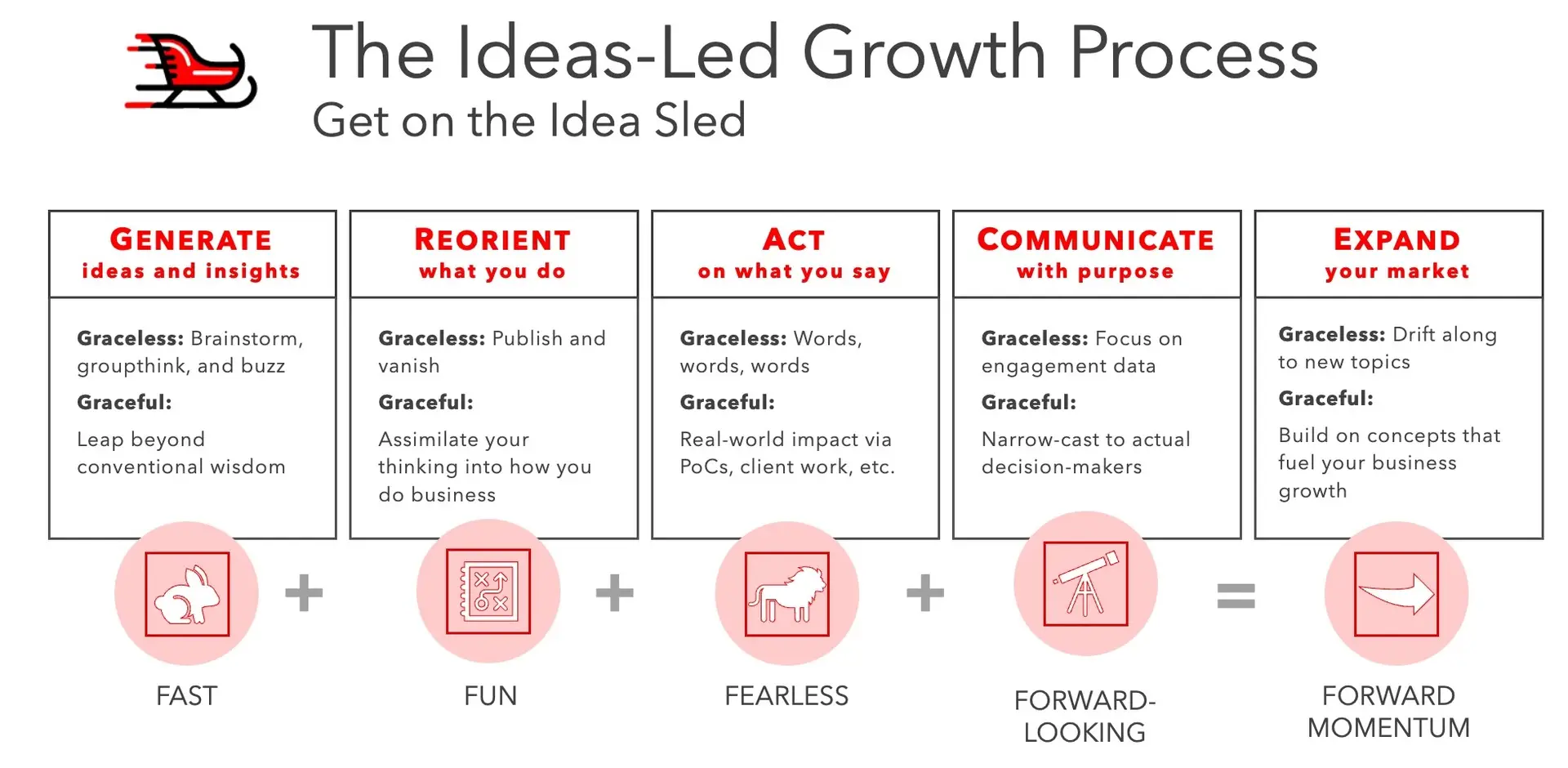Thought leadership should be fun, fast, and fearless. You tap into excitement about new ideas and advocate for something better. That’s the mindset behind The Idea Sled. Projects glide forward gracefully. It’s the momentum of commitment. This newsletter shows you how.
You can spend weeks crafting strategic messaging that seems perfect. By the end, every stakeholder has provided input. You’ve conducted interviews and done your research. You’ve written countless drafts and revisited each word. You’ve secured buy-in up and down the chain of command. It was a long and challenging project, but everyone loves it. What a success!
But here come the scary questions. How do people respond to your messaging? Do they believe it? What feelings does it evoke? How does it change their perceptions and behaviors?
You can easily discover that your intended audiences, from employees to clients to influencers, still don’t hear what you think you’re saying.
Matters of Interpretation
Language is more fluid than we like to believe. Words and concepts mean different things to different people. Culture, context, character, and even contingent factors like mood and daily events change how people receive your messaging.
After all, if you’re truthful with yourself, you’d have to admit all those factors affect your understanding most of the time. It’s only when you make a good faith effort to interpret without cognitive or emotional bias—if even then—that you can approach whatever a message intends.
The concept of good faith effort also often inadvertently creates a distortion field because a small team within a company has dedicated exactly such efforts to crafting perfect messaging. No one else has spent as much time or given it as much thought as you. It becomes nearly impossible to look at your messaging through the eyes of a biased and distracted recipient when you’ve worked so hard on it.
Five Ways to Escape the Distortion Field
That’s not to say that messaging is futile, however. It simply affects how companies should approach their messaging and then put it to work.
1. Solve the Right Problem
Tangible goals have a tendency to replace complex, intangible, strategic objectives. In messaging initiatives, finishing the message framework becomes the outcome. It’s understandable because you want the project to end, to be able to check it off or call it an achieved OKR. But a finished document is the result, not the purpose of strategic messaging work.
To stay on the right track:
- Never forget that the real problem you’re trying to solve is influencing how people perceive and interact with your brand in the context of all the other brands they encounter. Interactions can include purchases, progressing to next steps in a sales or marketing journey, accepting a job offer, achieving excellence, etc.
- Figure out those desired perceptions and engagements, then codify them as your team charter. Everything you do should connect to what influences people to say “yes” to your brand in response to some strategic offer. That’s the final test for the strategic value of your messaging. However, don’t forget these “yes scenarios” may evolve and mature as you work through the messaging.
- Create norms within your team that keep your ultimate problem top of mind. Make it a normal course of business to review and test your output against your desired outcomes.
2. Treat Creeping Consensus With Skepticism
Usually, a small working group leads the process of creating messaging for a brand or product line. As countless psychology studies have shown, group dynamics can alter people’s perception of reality.
As consensus emerges, it starts to replace an outward-looking point of view. Teams with similar backgrounds and thought processes often reinforce each other’s biases. This resonance creates a reality where the outside world looks exactly like what’s being discussed inside the room.
Consensus also starts to feel deceptively good. It takes the place of validation. The team’s focus shifts from understanding market dynamics or customer needs to proving their messaging is ‘right.’ Then they mistake emerging alignment for relevance and fit for the intended effect.
To counteract consensus:
- Build skepticism into your team. Make it a common practice to ask “why” all the time.
- Push people to explain how they came to conclusions. My favorite questions are “How do you know the opposite isn’t true?” and “How certain are you?”
- Try not to let more than two or three meetings go by without bringing in some external perspective, from within your company but outside your team or from people who reflect your real-world audience.
3. Resist Power Dynamics
Have you ever been in a presentation where senior executives derail everything because they “want” something? Of course you have. Many times, it’s rational, but it could have been avoided by managing upwards better. But it often comes down to arbitrary preference.
The risks are severe. When leaders hold disproportionate power in strategic discussions, teams can fall into the trap of shaping their ideas to align with leadership preferences. A culture of deference and appeasement stifles critical thinking and innovation. Strategic planning can become distorted when authority figures create a ripple effect where everyone’s thoughts converge with theirs out of respect or fear.
The result? Missed opportunities, slow adaptation to external changes, and strategies that serve internal power structures rather than the market or customers.
These dynamics play out within a team as well, when a senior participant dominates conversations and prioritizes ideas that mirror their preferences rather than pushing for ideas rooted in data or external realities. Either direct authority or perceived influence can have this effect.
To break through power and influence dynamics:
- Begin any leadership presentations with your goals first. Tell them what problem you are trying to solve and show them why what you are presenting achieves that end. Never ask for open-ended feedback or reactions to an interim or final product. This methodical process can still happen within a brief meeting. If anything, it keeps the meeting shorter by keeping it on track
- Make your team a safe zone where people tolerate and encourage disagreement without negative career consequences. What happens in planning meetings stays in planning meetings—no retribution or grudges.
- Be tough while prioritizing inclusiveness and kindness. Everybody speaks and does so respectfully.
4. Be the Naysayer Before Anyone Says Nay
Strategic messaging that is resistant to feedback from naysayers is often fragile. Teams can stress-test their strategic messaging by imagining the harshest critics. In many cases, it’s no stretch of imagination. Your own colleagues will be happy to tell you that what you’ve developed sounds nothing like what your company stands for or does.
To act as your own worst naysayers:
- Anticipate weak points and strengthen your messaging before it’s ever challenged. The idea of a devil’s advocate may seem trite, but you can use it effectively to simulate multiple scenarios where the messaging could be misunderstood, mocked, or ignored.
- Lean into objections. They can reveal unexpected gaps or misconceptions that your messaging needs to overcome or force you to strengthen proof points that will benefit your messaging in the end.
- Beware of preposterous opposites. A common flaw of messages is inserting points whose opposite would be ridiculous. For example, don’t simply say you’re innovative or fast; no company wants to be known for being antiquated or slow. Those flaws often become the cracks that cause messaging to crumble in the face of criticism or cynicism.
5. Distinguish Signal From Message
Sometimes, people are shocked (and I’m shocked that they’re shocked) by the idea that strategic messaging isn’t necessarily the exact wording of what you say in communication and marketing outputs. Think of it this way. People aren’t computers. They don’t simply and literally follow instructions that you input.
More important, strategic messages are outcomes. They reflect the beliefs and actions you want to instill in your intended audiences. What you say in a specific instance—such as an internal comm, a press release, a marketing asset, a thought leadership article, or even an ad—should help lead to that outcome.
For example, if you offer a platform or service to investment managers who manage many billions of dollars, you may want to reinforce a message of trust and reliability. “X is the platform you can trust” might be an element of your strategic messaging, but you can’t just say that verbatim and expect people to believe it. You can’t expect a one-off piece of content to convince anyone.
To reframe your messaging as outcomes:
- Repeat, reinforce, and repeat again. You should quickly transition from messaging to planning how to get those messages into people’s minds. It will include campaigns, multiple strategies, and a steady cadence of assets with phrasing and narratives that express your messaging, create belief, and inspire action. It takes time and frequent touchpoints for a message to gel in people’s minds as the “yes” you want to create.
- Remember to show rather than tell. My concluding message about messaging is, of course, a point about thought leadership. You can’t just say who you are and expect people to accept it at face value. You have to demonstrate credibility, which you do by showing that you have done what you say, that you have thought it through, and that you can help people reframe their thinking about needs and challenges constructively. That’s true for trust—and applies to any other messaging attribute you imagine, too.

Don’t just claim value. Demonstrate it. Crafting strategic messaging is more than just getting words on paper—it’s about anticipating what those words will create.
The most robust strategies embrace dissent, question authority dynamics, and stress-test every message against potential objections. To move forward, commit to a culture of critical thinking and constant refinement.
Before you embark on a strategic messaging initiative, consider these guiding questions:
- Are you focusing on solving the real problem?
- How will you mitigate getting caught up in consensus and internal validation?
- How well have you stress-tested your messaging against the harshest critics—both inside and outside your organization?
- Are power dynamics influencing your messaging decisions in ways that prioritize internal satisfaction over external impact?
These questions will help ensure your messaging resonates in real-world engagements, not just in the boardroom.

Three Grace Notes
“The more we spend our days staring at screens, taking our dreams and directives from the signs and shapes that play across their smooth surfaces, the easier [it becomes] to simply stay ensconced within a universe of images neatly honed to meet our needs.” —David Abram, Becoming Animal: An Earthly Cosmology
“If you’re trying to influence a market, the rules are different. Sure, some of the people in a market have considered you (and even rejected you). But most of the people in the market have never even heard of you. The market doesn’t have just one mind. Different people in the market are seeking different things.” —Seth Godin, The Dip: A Little Book That Teaches You When to Quit (and When to Stick)
“This quality of rushed busyness expresses in action the absence of vision in thought, the absence of principles that establish coherence and priority.” —Thomas de Zengotita, Mediated: How the Media Shapes Your World and the Way You Live in It
Note: The links above are affiliate links. I’m using them in lieu of paid subscription tiers or digital tip jars. Seems like a much more graceful way to generate financial support while sharing more thinking and writing that can guide thought leadership.




